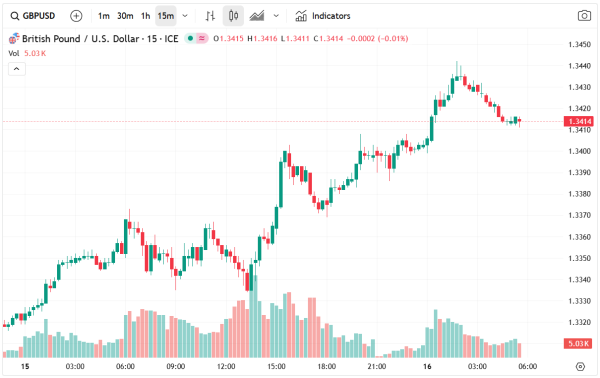The GBP/USD exchange rate has been under pressure in recent sessions, with investors closely monitoring developments in both the U.S. and U.K. economies. On Wednesday, the pair remained largely flat, trading at 1.3330, down from a September high of 1.3725. Katie Davis, a broker at ProMorion Group, provides a comprehensive breakdown of this topic in this article.
Market participants reacted to key statements from Federal Reserve Chair Jerome Powell and Bank of England Governor Andrew Bailey, while UK labor data further reinforced a bearish outlook for the British pound.
Jerome Powell and Andrew Bailey Statements
The GBP/USD pair initially traded in a tight range following a relatively dovish statement from Jerome Powell. Powell indicated that the Federal Reserve may pause the balance sheet reduction in the coming months, a significant shift aimed at preserving liquidity in overnight funding markets. This move suggests a cautious approach to monetary policy, as the central bank navigates weaker labor conditions amid macroeconomic uncertainty.
Powell also highlighted concerns about the U.S. labor market, noting that employment data for September was unavailable due to the government shutdown. Nevertheless, an ADP report revealed that the private sector lost 36,000 jobs in September. This development reinforces expectations that the Federal Reserve may deliver another interest rate cut in October, potentially lowering the official cash rate to between 3.75% and 4%.
Meanwhile, the GBP/USD exchange rate reacted to UK labor data released by the Office of National Statistics (ONS). The report showed the unemployment rate rising from 4.7% in July to 4.8% in August, reaching a four-year high. Additionally, jobless claims increased by 25,000, while payroll numbers fell by 10,000, signaling that the UK economy is struggling.
These indicators point toward a period of stagflation, characterized by high inflation and slow economic growth. In response, Andrew Bailey expressed surprise at the weak jobs data, highlighting the delicate balance the Bank of England (BoE) faces in deciding whether to cut interest rates. Economists suggest that there is only a slim chance the BoE will reduce rates before the end of the year, reinforcing pressure on GBP/USD.
GBP/USD Technical Analysis
From a technical perspective, the daily chart shows the GBP/USD exchange rate wavering in recent sessions. Currently trading at 1.3327, the pair is only slightly above this week’s support level of 1.3250.
Key technical signals for GBP/USD include a drop below the 23.6% Fibonacci retracement level at 1.3390, indicating potential further downside. A head-and-shoulders pattern has formed, a classic reversal signal suggesting that selling pressure may increase. The next major support level is at 1.3140, coinciding with the lowest point in August.
These technical factors reinforce a bearish outlook, particularly if the pair fails to reclaim 1.3250. Traders are likely to target 1.3140, and any break below this level could accelerate downside momentum.
Key Market Drivers
Several fundamental factors are driving the bearish sentiment in GBP/USD. Dovish U.S. monetary policy is a key driver, as Powell’s comments signal a potential interest rate cut in the near term, weakening the U.S. dollar’s appeal in carry trades while also signaling caution in risk sentiment.
A weak UK labor market, highlighted by rising unemployment and declining payroll figures, suggests the UK economy is struggling, reducing investor confidence in the pound. Additionally, stagflation risks, with persistent inflation pressures and sluggish economic growth, create a negative environment for GBP/USD, limiting the BoE’s monetary flexibility.
Trading Implications
For traders, the current GBP/USD setup presents clear bearish signals, as a close below 1.3250 could trigger further downside momentum, with 1.3140 identified as the next key target. Short-term resistance is observed near 1.3390, coinciding with the 23.6% Fibonacci retracement level, which may act as a barrier to upward movements.

Technical traders should also keep an eye on the potential head-and-shoulders formation, as a confirmed pattern supported by volume and price action could accelerate a trend reversal.
In summary, GBP/USD is exhibiting extreme bearish behavior below 1.3250, supported by fundamental weakness in the UK labor market and dovish signals from the U.S. Federal Reserve. Both technical and fundamental factors suggest that sellers will continue to dominate, with further declines likely in the near term.
Conclusion
The GBP/USD forex signal indicates a strong bearish trend below 1.3250, driven by a combination of U.S. dovish monetary policy, weak UK employment data, and technical patterns signaling further downside risk.
Traders should remain cautious, focusing on key support levels, while monitoring any policy announcements from the Federal Reserve and Bank of England that could alter the currency pair’s trajectory.









